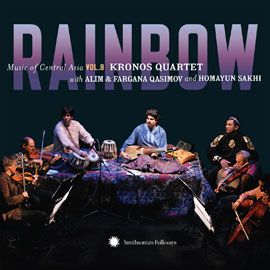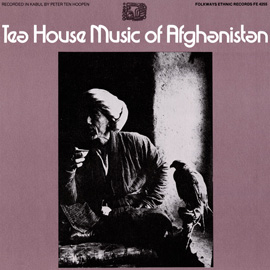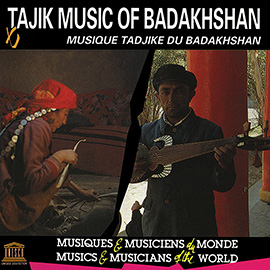Summary
The Afghan Rubâb is revered as Afghanistan’s “national instrument.” Despite censorship during the Taliban rule, the rubâb has regained its prominence in the Afghan culture. Skillful performers Ustâd Mohammad Omar and Homayun Sakhi continue to perform on the solo instrument leaving “their creative imprint on the region’s musical legacy. There can be no doubt that authentic traditional music remains forever contemporary.” (Sakhi, 2005)
Suggested Grade Levels: 6-8, 9-12
Country: Afghanistan
Region: Middle East
Culture Group: Kabuli
Genre: World
Instruments: Guitar, Drum
Language: Pashto
Co-Curricular Areas: Social Studies
National Standards: 2, 3, 6, 9
Prerequisites: None
Objectives:
- Listening: Instruments (Rubâb and Tabla)
- Analyzing: Form
- Playing: Rhythmic and melodic patterns
- Improvising: Yeman mode
- Anatomy and performance practices of rubâb
- Becoming acquainted with the geography of Central Asia and the political Climate of Central Asia (past and present)
- Understanding censorship of music
Material:
- “Emen/Tintal” by Ustâd Mohammad Omar from Ustâd Mohammah Omar: Virtuoso from Afghanistan, (SFW CD 40439)
- “Keliwali” by Ustâd Mohammad Omar from Ustâd Mohammah Omar: Virtuoso from Afghanistan
- Liner notes to Ustâd Mohammah Omar: Virtuoso from Afghanistan
- “Raga Yaman” by Homayun Sakhi from Homayun Sakhi: The art of the afghan rubâb
- DVD of Rubâb by Homayun Sakhi for Homayun Sakhi: The art of the afghan rubâb, (with purchase of the CD)
- Liner notes to Homayun Sakhi: The art of the afghan rubâb
- Map of Central Asia (Afghanistan, Pakistan, and India)
- Hand drums
- Guitars
- Baily, John (2001). Can you stop the birds singing?: The censorship of music in Afganistan
- Information about the Rubâb, the Tabla, and censorship of music is freely available online
Lesson Segments:
- “Keliwali” (National Standards 2, 6, 9)
- “Emen/Tintal” (National Standards 2, 3, 6, 9)
- Censorship in Afghanistan (National Standard 9)
- Raga Yaman (National Standards 6, 9)
Lesson Segment #1: “Keliwali” by Ustâd Mohammad Omar
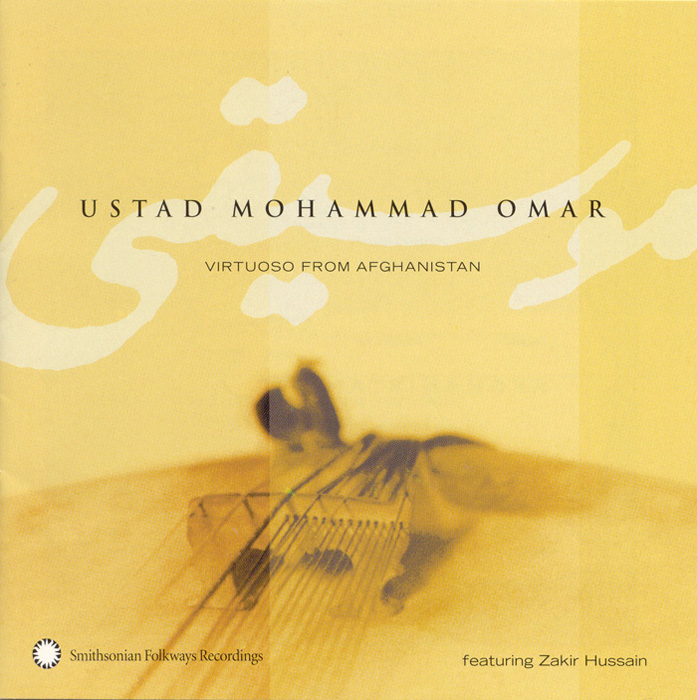
“Shakal and naghma in the melodic mode of emen (yeman)”
from Ustad Mohammad Omar: Virtuoso from Afghanistan (2002) | SFW40439
“Keliwali in the melodic mode of kastori”
Procedure:
1. Listen to recording.
- As you keep a steady beat with your feet, identify rhythm patterns used by the Rubâb and the Tabla.
- Play one of these patterns softly on a hand drum.
2. See the liner notes from Ustâd Mohammah Omar: Virtuoso from Afghanistan (pgs. 8 - 9) and Homayun Sakhi: The art of the afghan rubâb (pgs. 15 & 27) for a description of Rubâb and the Tabla and DVD of Homayun Sakhi: The art of the afghan rubâb - Interactive Glossary.
- Discuss the anatomy of the instruments.
- List materials used to construct the instruments.
- Display page 16 from the same liner notes and summarize the notes on the ensemble from page 12
3. View the DVD Homayun Sakhi: The art of the afghan rubâb - Art of the Afghan Rubâb starting at 20:40.
- Discuss performance practices for both instruments.
Assessment:Are students able to play the rhythms patterns accurately? Are students able to discuss the material in an age-appropriate manner?
Lesson Segment #2. “Emen/Tintal” by Ustâd Mohammad Omar
Procedure:
1. Listen to recording (this is a long piece - you may want to only use sections of it).
- This Afghan classical piece uses the melodic mode of Emen (Yeman) and rhythmic mode of Tintal (16 beats).
- It starts with an improvisatory introduction called a shakal, followed by the naghma (four sections):
- astir - principle melody
- antara - melody on “ni”
- bog - new short melody repeated in several different rhythmic settings
- 4. sanchai - another short melody
2. Play the melodic mode Yemen (C D E F# G A B C) on the guitar.
- The Yemen mode is represented by the Indian solfege syllables:
- sa, re, ga, ma, pa, dha, ni
(analogous to do, re, me, fa, sol, la, ti). - The yemen mode uses a raised fourth degree
3. Play the Yemen melody as transcribed below. See “Emen/Tintal” by Ustâd Mohammad Omar (pg. 11).

4. Improvise a short melody on the guitar using the pitches from the Yemen mode.
- Reflect on the performances of the improvised pieces
- Use of the correct pitches of the mode
- Ability to imitate the style
- Use of similar rhythms
Assessment: Are students able to hear and identify the altered pitch (raised 4th scale degree)? Are students able to improvise a short melody using the Yemen mode?
Lesson Segment #3. Censorship in Afghanistan
Procedure:
1. Liner notes from Ustâd Mohammah Omar: Virtuoso from Afghanistan (pgs. 2 - 3) and Homayun Sakhi: The art of the afghan rubâb (pg. 10) for information on censorship.
2. Baily, John (2001). Can you stop the birds singing?: The censorship of music in Afghanistan.
- Define censorship
- Discuss censorship of Afghan music by Taliban (see materials above)
- Discuss censorship in the US and Worldwide
Assessment: Are students able to discuss the material in an age-appropriate manner? Are students able to relate discussion to their own experiences?
Lesson Segment #4. “Raga Yaman” by Homayun Sakhi
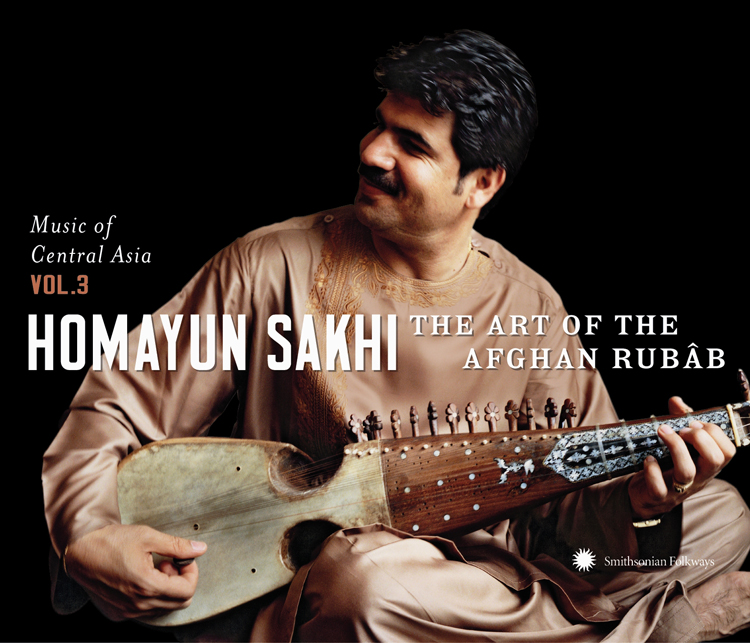
“Raga Yaman”
from Music of Central Asia Vol. 3: Homayun Sakhi: The Art of the Afghan Rubâb (2006) | SFW40522
Procedure:
1. Listen to recording.
- Discuss similarities and differences between Homayun Sakhi’s Yaman (Yeman) and Ustâd Mohammad Omar’s Yeman (Yaman)
- Define Ustâd-shagird (master-apprentice) relationship: see liner notes from Ustâd Mohammah Omar: Virtuoso from Afghanistan (pgs. 4-5) and Homayun Sakhi: The art of the afghan rubâb (pg. 12-13)
- Trace the musical lineage of Homayun Sakhi
- Homayun Sakhi from his father - Ghulam Sakhi
- from Ustâd Modammah Omar
- from Ustâd Ibrahim
- from family lines of the classically trained musicians of North India brought to Kubal by Amir Sher Ali Khan (1860s)
- Trace the geographical locations of Homayun Sakhi’s musical lineage on a world map
- Homayun Sakhi - Fremont, California (present home)
- from Khalil House in Peshawar, Pakistan
- from Kucheh Kharabat area in Kabul, Afghanistan
- from Northern India
- Identify some possible influences on Homayun Sakhi’s music from the Ustâd-shagrid experience and geographic re-locations
Assessment: Are students able to discuss the material in an age-appropriate manner? Are students able to identify geographic and familial experiences that could have influenced the music of Homayun Sakhi?




